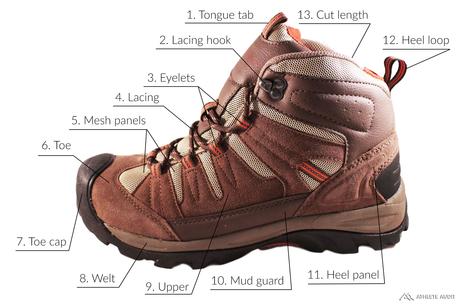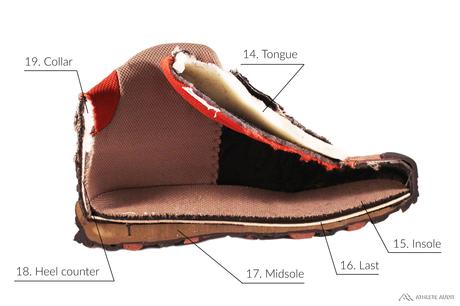Parts of a Hiking Boot



- Tongue tab – Helps to lift up the tongue for easy foot insertion
- Lacing hook – An open lace hook makes it easier to tighten/loosen boots
- Eyelets – Holes near the top of the upper guides laces into place
- Lacing – Durable, rounded laces stand up against the abuse of mother nature
- Mesh panels – Some hiking boots feature mesh panels that add ventilation
- Toe – The end of a hiking boot, oftentimes reinforced for added durability
- Toe cap – A rubber toe cap helps to improve durability as well as scrambling on rocks
- Welt – A strip of leather or rubber around the perimeter of the outsole, helps attach the outsole to the upper
- Upper – Usually made of tough materials such as leather or synthetic leather
- Mud guard – Helps to keep mud from plastering the upper
- Heel panel – The piece of fabric that covers the heel
- Heel loop – Can be used to make slipping on the boot easier or attaching to a carabiner for carrying
- Cut length – Hiking boots often refer to mid-tops or high-tops, while hiking shoes are often low-cut for added mobility
- Tongue – Heavily padded for increased comfort and protection
- Insole – The footbed of the boot, provides comfort and support for the feet
- Last – What a boot is built around; affects the shape and width of the boot
- Midsole – The cushioning located between the insole and outsole, is thick and firm
- Heel counter – The plastic insert behind the heel that provides structure and support for the heel
- Collar – A padded collar provides comfort and ankle support
- Outsole – A durable rubber outsole can be found on the bottom of a hiking boot
- Heel brake – Specific lug pattern helps to provide extra traction when braking with the heel
- Shank – Some hiking boots have a shank between the insole and outsole to provide support and structure. Helps to relieve load on hiker’s feet and calves
- Lugs – Deep, protruding rubber lugs help to provide traction on a variety of terrain

